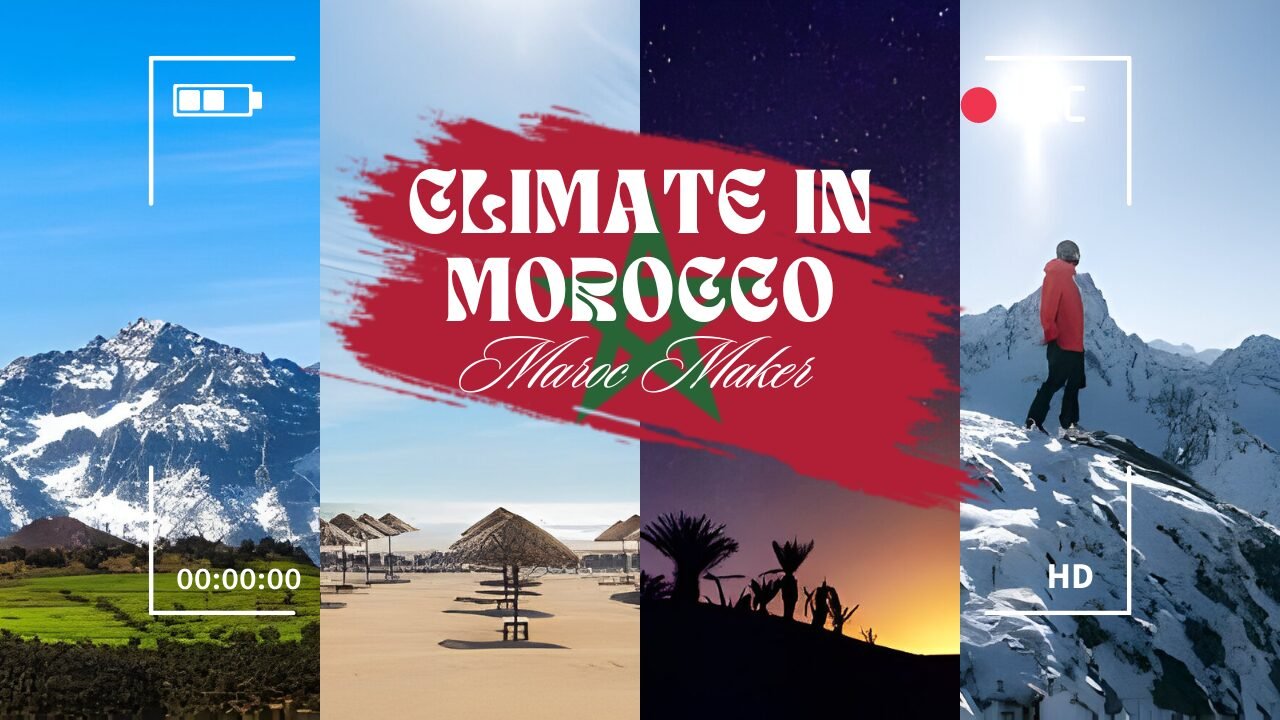Planning a trip to Morocco? It’s essential to understand the climate in Morocco and weather conditions in this diverse country to make the most of your experience. From the vibrant cities to the majestic Atlas Mountains and the breathtaking Sahara Desert, Morocco offers a wide range of landscapes that are influenced by various climate zones.
In this comprehensive guide, we will provide you with valuable insights and tips about the climate in Morocco. Whether you’re seeking sunny beaches, planning outdoor adventures, or exploring fascinating cultural events, understanding the weather patterns will help you plan your itinerary accordingly.
From the Mediterranean coast to the arid desert regions, each area in Morocco has its own unique climate and distinct seasonal variations. By learning about the different climate zones, you can pack the right clothes, prepare for specific weather conditions, and ensure an enjoyable trip.
Key Takeaways:
- Discover the diverse climate zones in Morocco, from the Mediterranean coast to the Sahara Desert
- Understand the variations in temperature, precipitation, and humidity throughout the year
- Plan your visit based on the best time for cultural events, outdoor activities, or beach vacations
- Pack appropriate clothing and gear to suit the weather conditions in different regions
- Explore seasonal highlights and activities, including trekking in the Atlas Mountains and relaxing on the Moroccan coastline

Weather in Morocco
When planning your trip to Morocco, it’s essential to have a good understanding of the weather conditions throughout the year. The climate in Morocco is diverse, varying from region to region and influenced by the country’s proximity to both the Atlantic Ocean and the Sahara Desert.
Morocco experiences a Mediterranean climate along its coastal areas, characterized by hot summers and mild winters. Inland regions, such as the Atlas Mountains and the Sahara Desert, have a more arid and desert-like climate. The weather in Morocco can be quite unpredictable, so it’s always a good idea to be prepared for sudden temperature changes and fluctuating conditions.

Now, let’s take a closer look at the weather variations in Morocco month by month:
January
January sees diverse weather in Morocco, with variations based on location. Coastal towns like Casablanca and Rabat enjoy moderate weather, unlike Marrakech and Fes which face colder conditions. The country may get rain with the Atlas Mountains getting a heavier dose, sometimes even snow.
February
February’s weather mirrors that of January. The temperatures continue to be nippy, possibly icy. Most places might witness showers, while higher terrains could experience snow. If seeing snow-topped mountains of Morocco excites you, it’s a good time to go!

March
As March arrives, the chill fades and the climate turns agreeable. Beachfront locales bask in gentle warmth, just right for sandy strolls and seafront fun. Meanwhile, towns away from the coast, like Marrakech and Fes, feel the heat creep in, offering perfect conditions for tours and exploration.
April
April brings warmer weather to Morocco. As the heat rises, tourists begin to crowd the coast. Away from the shore, the lands are hot in daylight but cool off when night falls. The Atlas Mountains offer adventure, perfect for exploring and outdoor fun.
May
When May arrives, Morocco basks in cozy, delightful weather, marking it as a superb vacation destination. Beach plans are perfect for the coastal areas while mountainous regions present scenic treks. Discover the alluring lanes of Chefchaouen, or kick back in the dynamic vibe of Marrakech.

June
Summer kicks off in Morocco as June rolls around, blessing the country with warmth. The coast offers a cool retreat from the balmy conditions, but deserts may turn into hot zones under the noon sun. To steer clear of the hottest part of the day, considering timing your adventures for dawn or dusk would be a smart move.
July
July brings the year’s peak heat to Morocco. Coastal areas stay comfy, yet areas like Marrakech and the desert get really hot. Staying watered is key, and being cautious during desert adventures or other daytime outings is a must.

August
In August, the weather mirrors July’s warmth. Beach locations attract most visitors, while mountains provide a chillier escape. It’s an excellent period to tour the seaside towns and bask in the lively summer mood.
September
As September rolls in, Morocco’s climate takes a turn for the cool. It’s a prime time for adventure, with coasts keeping their charm and deserts tamed for fun camel rides and expeditions.

October
October in Morocco presents pleasant weather, perfect for a visit. The coastline provides a blend of beach lazing and culture diving, while the mountains display stunning fall shades. It’s a favored time for being active outdoors and exploring sights.
November
When November hits, Morocco’s inland simmers down with chillier weather. Yet, the coast maintains a warmer charm, perfect for sunbathing or sightseeing. This is ideal for adventuring through cities like Marrakech and Fes and taking on the excitement of desert escapades.
December
As December rolls in, it becomes colder everywhere. Places by the sea still feel rather warm. In contrast, the mountains are perfect for wintertime games. This month is the perfect moment to experience Morocco’s special mix of Christmas and Moroccan customs.
By considering the month-by-month breakdown of weather conditions in Morocco, you can choose the best time to visit based on your preferences and activities. Whether you’re planning a beach vacation, a trek in the mountains, or immersion in the local culture, understanding the weather in Morocco will help you make the most of your trip.
Climate in Morocco
Climate in Morocco varies significantly across different regions, resulting in a diverse range of environments to explore. From the moderate Mediterranean climate along the coast to the dry and extreme temperatures in the Sahara Desert, Morocco offers a unique experience for travelers.
The Mediterranean Climate
Along the northern and western coast of Morocco, you will find the Mediterranean climate. This region experiences mild winters and warm summers, with average temperatures ranging from 10°C (50°F) in winter to 27°C (81°F) in summer. The coastal areas also receive moderate rainfall, making them lush and green.
The Atlas Mountains
As you move inland and ascend into the Atlas Mountains, the climate becomes cooler and more continental. The higher altitudes bring colder temperatures, especially during the winter months, and the mountains are often covered in snow. Summers in the Atlas Mountains are pleasant and offer relief from the heat of the lower-lying areas.

The Sahara Desert
Heading southeast towards the Sahara Desert, you’ll encounter an arid desert climate with scorching temperatures during the day and cool nights. Summers can be extremely hot, with temperatures soaring above 40°C (104°F), while winters are milder, with daytime temperatures averaging around 18°C (64°F). Rainfall is minimal in the desert, making it a dry and arid region.
The High Plateaus
In Morocco’s elevated regions, cities such as Marrakech and Fes exist. They face a semi-dry weather condition. During summers, it gets pretty hot and dry, temperatures can even hit 35°C (95°F) and above. Winter is a different story in the high plateau areas. Days are cool, the average temperature hovers around 14°C (57°F), and nights can be colder.
Understanding the climate in Morocco is essential for planning your trip and ensuring you have the right clothing and equipment. Whether you’re exploring the coastal regions, trekking in the mountains, or venturing into the desert, being prepared will enhance your travel experience.
Seasonal Highlights and Activities
When planning your trip to Morocco, it’s important to consider the seasonal highlights and activities that are available throughout the year. Each season offers its own unique experiences, and understanding the climate in Morocco can help you make the most of your visit. Whether you’re interested in cultural events, outdoor adventures, or beach vacations, there’s something for everyone in this diverse country.
Spring (March to May)
Visiting Morocco in spring is great! The weather’s just right – not too hot, not too cold. There’s a nice rise in temperature. You’ll see flowers blooming all around, the scenery beautiful and green. Imagine exploring Marrakech and Fes, cities full of life. There’s so much to see; colorful bazaars, superb buildings. And the Atlas Mountains? Perfect for hiking in spring’s mild weather.

Summer (June to August)
Morocco’s summer brings heat, particularly in desert areas. Yet, for beach enthusiasts, this is the ideal time to explore the coast. You can consider Essaouira or Agadir for leisurely beach holidays, soaking in sunshine and savoring cool ocean winds. It’s a fine time for water sports like surfing and kiteboarding too. As night falls, you can sample tasty seafood at coastal eateries.
Fall (September to November)
Morocco in autumn is superb! The scorching summer sun mellows, making way for outdoor fun. Maybe you fancy a Sahara Desert or Atlas Mountains adventure? It’s picnic and camping time. Harvest season is here too! The Moroccan countryside comes alive with the hustle of olive and grape picking. A visit to the delightful Chefchaouen is a must see. Its blue-tinted structures and fantastic mountain vistas will amaze you.
Winter (December to February)
Winter is not so harsh in Morocco. Isn’t it the best time to check out Rabat and Meknes, the royal cities? Immerse yourself in a unique culture, rich in history. You can visit world-renowned spots listed by UNESCO. Take in the beauty of grand buildings, also known as palaces. Up for winter games and sports? The Atlas Mountains are for you. Skiing down snow-covered slopes or snowboarding is fun. Warm up your evenings in traditional riads by a roaring fireplace. Experiencing Moroccan cuisine is a must during your stay.
| Season | Highlights | Activities |
|---|---|---|
| Spring (March to May) | Blooming flowers and lush landscapes | Exploring cities, hiking in the Atlas Mountains |
| Summer (June to August) | Sunny beaches and water sports | Beach vacations, surfing, kiteboarding |
| Fall (September to November) | Cooler weather and harvest festivals | Hiking, camping, visiting Chefchaouen |
| Winter (December to February) | Mild winter weather and historical sites | Exploring cities, skiing in the Atlas Mountains |

Conclusion
After exploring the diverse climate in Morocco, it’s clear that this country offers a wide range of weather conditions and experiences. From the Mediterranean climate along the coast to the arid desert climate of the Sahara, Morocco has something to offer every traveler.
When planning your trip, it’s essential to consider the weather and climate in Morocco. Whether you’re seeking a beach vacation, a trek through the Atlas Mountains, or a cultural exploration of the bustling cities, understanding the local climate will help you make the most of your visit.
Don’t forget to carry suitable clothes for diverse weather and seasons. Ready yourself for hot summers and cold winters, anticipate varied rainfall during the year. Thinking about the weather, you can assure a cozy and fun trip.
Check out our Morocco Climate Guide. It’s your go-to resource for planning your trip. If it’s the picture-perfect cities, stunning views, or lively culture that’s caught your eye, Morocco’s weather only adds to the allure. Start your unforgettable adventure to this truly magical place.











Comments are closed